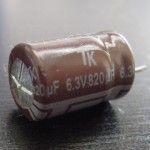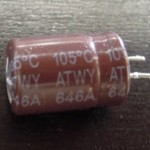Like most consumer electronics, computers tend to break down due to low quality capacitors that fail before their time. In this example, my brother’s computer switched itself off after a period of instability, and would not turn on again.
Visual inspection revealed a bulging capacitor close to the south bridge. (Look at the pictures below, the top plate with the vents is bulging slightly) I de-soldered the part:
As you can tell from the pictures, the part is:
Manufactured by TK, max voltage 6.3V, capacitance 820uF, max operating temperature is 105 degrees Celsius, and it’s from the ATWY series. 646A is a date code.
In most electronics repair situations you’d simply replace the broken capacitor with a new one of equal capacitance and the same or higher voltage rating. This part measured an ESR of less than 1.1 ohms, which for most circuits would indicate a healthy component. In modern computers however, specs are much tighter, and parts that would work perfectly in most circuits can make a computer fail.
A google search for “TK ATWY” led me to the data sheet, which revealed that this 6.3V, 820uF capacitor has an Impedance (other word for ESR) of 0.036ohms, and a max ripple current of 1140mA.
We’re looking for a part with the following specs:
Capacitance: 820uF (this value must be identical to original part)
Voltage: 6.3V (this value can be equal or higher)
Temperature: 105C (look at the placement of the part; how hot will it get in that position? In this case, very close to the South Bridge; 105C or more is recommended)
Impedance/ESR: 0.036 ohms (this value must be equal or lower, but not too much lower)
Max Ripple current: 1140mA (this value can be equal or higher)
Physical dimmensions: Diameter: 8mm (just make sure the part you order will fit on the board)
Then simply make sure you get the polarity right, and the board should work again. If not, this means the failing capacitor probably blew other components as it went out of spec. In most cases, replacing the faulty capacitor(s) solves the problem.
After a repair like this it’s probably a good idea to clear CMOS+RTC, just in case something got corrupted when the computer became unstable.



Wow! This could be one particular of the most helpful blogs We’ve ever arrive across on this subject. Actually Great. I’m also an expert in this topic therefore I can understand your hard work. 562676
Very Useful tips. Thank u.